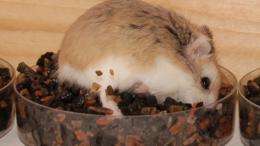New hypothesis proposed on why some seeds are hard

Hard seeds are prevented from germinating by a water-impermeable seed coat, and for many years this has been considered to be a dormancy mechanism. Scientists from Kew, the University of Bergen and the University of Sheffield have proposed an alternative 'crypsis hypothesis': that hard seeds evolved to hide from mammalian predators.
Hard seeds escape detection by hamsters
The team offered desert hamsters (Phodopus roborovskii) seeds of two legume species (Robinia pseudoacacia and Vicia sativa) that had dimorphic seeds (hard and soft). The seeds were offered either on top of or buried in dry or wet gravel. The hamsters readily detected hard and soft seeds on the gravel surface and soft seeds buried in wet gravel, but hard seeds buried beneath either dry or wet gravel remained undiscovered.
Analysis with gas chromatography-mass spectrometry showed that volatile emission from dry hard and soft seeds of both species was very low. When in contact with wet gravel, soft seeds imbibed water and the volatile emissions increased greatly due to the resumption of metabolism. Hard seeds did not imbibe, and volatile emission remained low.
Hamsters could locate buried vials containing artificial volatile mixtures, which mimicked the scent of imbibed soft seeds, confirming that seed volatiles were the olfactory cue for discovery of buried caches.
New explanation for hard seededness
Hard seededness occurs in only 15 plant families, yet is a frequent trait in hot deserts where granivory by small rodents exerts strong selection pressure on seeds to evolve methods of avoiding detection. Many plant species rely on scatter hoarding by rodents for dispersal. Hard seededness facilitates seed dispersal because caches of hard seeds are more likely to escape being recovered and eaten by the hoarder or pilfered by neighbours. This could also explain why plants continue to produce some soft seeds, which can be viewed as payment for dispersal services.
This study, published in the journal New Phytologist, re-writes the evolutionary explanation for hard seeds and adds a new perspective to our understanding of seed dispersal and dormancy.
More information: Paulsen, T.R., Colville, L., Kranner, I., Daws, M.I., Högstedt, G., Vandvik, V. & Thompson, K. (2013). Physical dormancy in seeds: a game of hide and seek? New Phytologist 198, 496 - 503.
Journal information: New Phytologist
Provided by Royal Botanic Gardens, Kew












.jpg)






